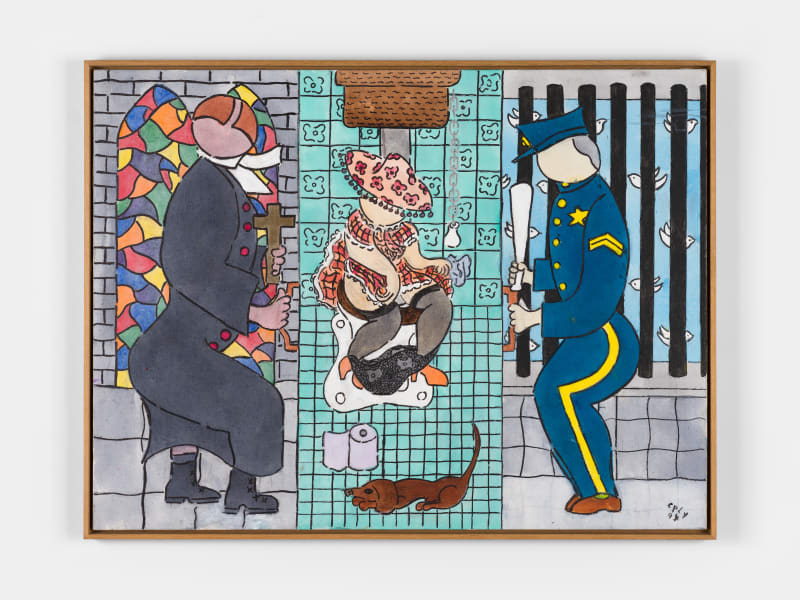William N. Copley 1919-1996
"When I search for higher distinctions in the world of art I go straight to the works of Bill Copley. To his great distinction, his paintings are like no other paintings in the world." —Ed Ruscha
William Nelson Copley’s pioneering body of work is defined by humorous, erotic, and political figurative paintings that explore themes of fantasy, morality, and the inner realm of self and experience. A self-taught artist, and gleefully impervious to dominant trends in art, Copley engendered a singular style over the course of five decades, assembling a unique lexicon of poetic imagery rendered in vivid colors and flattened pictorial space. Employing a distinctive use of line, Copley developed an idiosyncratic visual language incorporating curvilinear figures and recurring motifs, drawing on his fascinations and obsessions. Working under the moniker “CPLY,” which Copley used as his signature, the artist also created numerous drawings, collages, sculptural objects, prints, artist’s books and multiples.
Critically and with wry wit, Copley’s work explores fundamental elements of the human experience—tragedy and comedy, desire and fear—through a wide-ranging repertoire of thematic subjects. Developing what he called a “private mythology”—a recurring cast of characters, situations, and personal images that provided crucial catalysts for his pictorial ideas across numerous artwork series—Copley imbued a poetic dimension to his paintings, indicative of his literary background. Though deeply influenced by the Surrealists, Copley’s contributions to art history ultimately defy categorization, and they cast a lasting legacy on contemporary art that continues to reverberate today. As artist Ed Ruscha, who knew Copley personally, has said of his work: “To his great distinction, his paintings are like no other paintings in the world.”
As Copley developed his signature themes and subjects, his aim to shock audiences became a hallmark of his career—one that curator Alison M. Gingeras has traced to a tradition of painters working in Paris, from Édouard Manet to Francis Picabia, an artistic hero of Copley’s. After developing formative friendships with artists Max Ernst, Man Ray, and Marcel Duchamp, Copley staged his first solo exhibition at a Los Angeles bookstore in 1951, just before moving to France where he lived and worked in Paris and Longpont-sur-Orge until 1962. In Paris, he took a studio on the famed Impasse Ronsin, alongside Constantin Brancusi, Claude and François-Xavier Lalanne, and others. Copley’s stylistic developments in France include complex and multilayered compositions depicting cars and street scenes; a use of extensive patterning, silhouetted images, nude women, bowler-hatted men, dachshunds, police officers, umbrellas, and the famous IBM slogan “THINK”; and his satirical paintings and textiles of national flags, deriving a pointed skepticism from his military experience during World War II. The artist also employed irreverent references to icons of art history, including the paintings of Hieronymous Bosch and the Pre-Raphaelite Brotherhood. By the end of his tenure in France, Copley’s signature, layered compositional style riffing on historical traditions such as the frieze, as well as pop cultural formats including the comic strip, had emerged.
Upon his move to New York in 1962–63, in the heyday of Pop, Copley continued to exhibit his steadfastly personal work widely across the United States and Europe. Following a decisive change in medium from oil to acrylic, Copley advanced the critical position he cultivated in Paris. These years would see Copley working in a luminous color palette, experimenting with collaged lace on his painting surfaces; in later years Copley would add fetish elements such as women’s shoes and lingerie directly to his paintings. In the late 1950s, Copley began a decades-long professional relationship with gallerist Alexander Iolas, who would present significant bodies of Copley’s work at his New York and Paris galleries. These include the landmark series Projects for Monuments to the Unknown Whore in 1966, which riffed on war monuments to eulogize socially-marginalized sex workers, a subject Copley would revisit in a major installation at the New Museum in 1986. In 1974, Copley debuted his watershed X-Rated series of humorous and overtly sexual paintings and charcoal drawings at the New York Cultural Center; in 2010, Kasmin presented a large-scale recreation of the exhibition. A comprehensive retrospective of Copley’s work, curated by Johannes Gachnang, opened at Kunsthalle Bern in 1980 before traveling to the Centre Georges Pompidou, the Stedelijk Van Abbemuseum, and the Badischer Kunstverein through 1981. By this time, Copley had moved part-time to Roxbury, Connecticut and began spending winters in the Florida Keys. He continued to work until his death in 1996.
MUSEUM EXHIBITIONS & COLLECTIONS
In 2016, The Menil Collection in Houston, Texas, opened a comprehensive survey of Copley’s work, which traveled to Fondazione Prada in Milan, Italy. Other notable solo and two-person exhibitions have been staged at the Philara Collection, Düsseldorf (2023-24); Institute for Contemporary Art, Miami (2018-19); Museum Frieder Burda, Baden-Baden (2012); Ulmer Museum, Ulm (1997), Kestner-Gesselschaft, Hannover (1995), Kunsthalle Bern, traveling to Centre Georges Pompidou, Stedelijk Van Abbemuseum, and the Badischer Kunstverein (1980-81), Stedelijk Museum Amsterdam (1966), and the Institute of Contemporary Art, London (1961). Copley’s work has been included in landmark group exhibitions including documenta 5 (1972); documenta 7 (1982); Pop Art USA, Oakland Art Museum, California (1963); “Bad” Painting, New Museum, New York (1978); and Westkunst, Museen der Stadt, Cologne (1981). His work is held in major public collections worldwide, including the Art Institute of Chicago; Centre Pompidou, Paris; Fondazione Prada, Milan; Los Angeles County Museum of Art; Moderna Museet, Stockholm; Museum of Modern Art, New York; Museum Ludwig, Cologne; Museum Moderner Kunst Stiftung Ludwig Wien, Vienna; Philadelphia Museum of Art; Stedelijk Museum Amsterdam; Tate, London; and the Whitney Museum of American Art, New York, among others.


